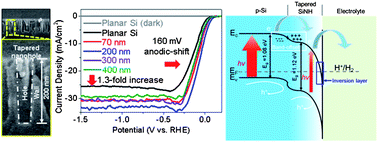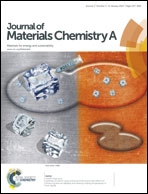Photoelectrochemical water splitting employing a tapered silicon nanohole array†
Abstract
An effective photocathode adopting a tapered Si nanohole (SiNH) array has been developed for photoelectrochemical water splitting. The tapered feature of SiNH photocathodes resulted in a gradation of the refractive indices between Si and air, such that the mismatching of optical impedance was alleviated and light absorption was enhanced. Adjusting the depth of the SiNHs successfully simulated the number of dielectric layers, optimizing the destructive interference for an antireflective coating (ARC). Only a 200 nm-thin NH array was required to absorb ∼96% of solar spectral irradiance for photoelectrochemical applications. This thickness also minimized the undesirable surface recombination loss. When compared to a similar system using a planar technology, the formation of NHs was observed to cause an increase in the optical bandgap. This could generate a surface-passivation effect, resulting in a lowering of dark current and an increase in photovoltage, which could be utilized for an anodic shift of the onset voltage. Due to the addition of tapered SiNHs, the photogenerated current was improved by ∼30% (∼33 mA cm−2) compared to a planar counterpart (∼25 mA cm−2), while the overpotential required for H2 evolution was reduced.


 Please wait while we load your content...
Please wait while we load your content...